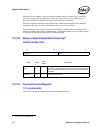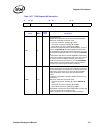
Software Developer’s Manual 311
Register Descriptions
Table 13-78. AIFS Register Bit Description
13.4.36 Transmit Descriptor Base Address Low
TDBAL (03800h; R/W)
This register contains the lower bits of the 64-bit transmit Descriptor base address. The base
register indicates the start of the circular transmit descriptor queue. Since each descriptor is 16 bits
in length, the lower four bits are ignored as the Transmit Descriptor Base Address must point to a
16-byte aligned block of data.
Table 13-79. TDBAL Register Bit Description
31 16 15 0
Reserved Adaptive IFS
Field Bit(s)
Initial
Value
Description
AIFS 15:0 0b
Adaptive IFS Value (82544GC/EI only)
Adaptive IFS throttles back-to-back transmissions in the
transmit packet buffer and delays their transfer to the CSMA/CD
transmit function. Normally, this register should be set to 0b.
However, if additional delay is desired between back-to-back
transmit packets, then this register can be set with a value
greater than zero (0). This feature can be helpful in high collision
half-duplex environments.
In order for AIFS to take effect it should be larger than the
minimum IFS value defined in IEEE 802.3 standard.
AIFS has no effect on transmissions that occur immediately
after receives or transmissions that are not back-to-back. In
addition, it has no effect on re-transmission timing (re-
transmission after collisions).
The AIFS programming value is in units of 8 ns (TX_CLK), and
is 16 bits wide, thus providing greater flexibility and maximum
delay value comparing TIPG.IPGT. The AIFS value is additive to
the TIPG.IPGT value.
Adaptive IFS Value (all remaining Ethernet controllers)
This value is in units of 8 ns.
Reserved 31:16 0b
Reserved
Should be written with 0b.
31 43 0
TDBAL 0


















